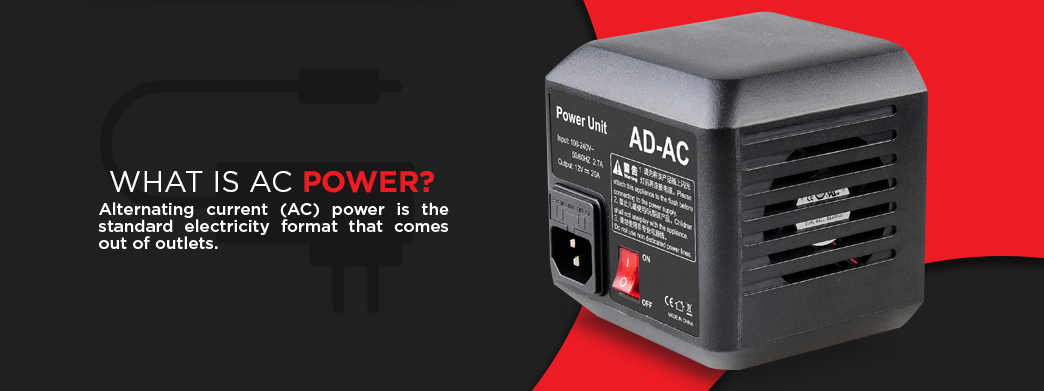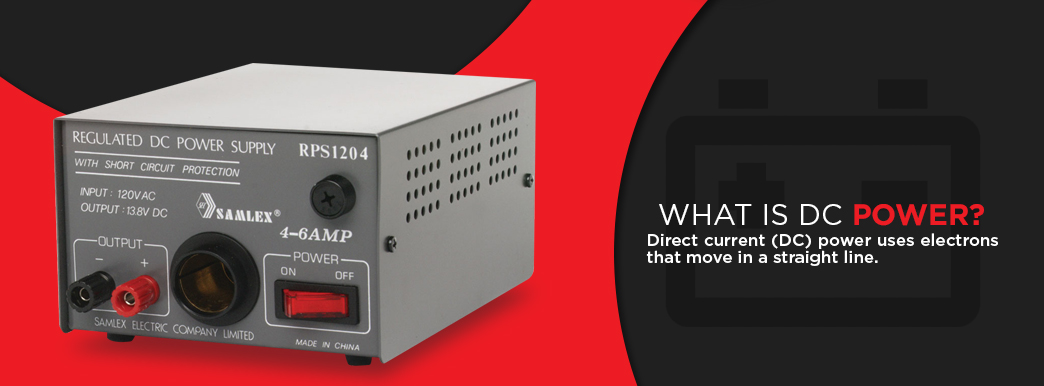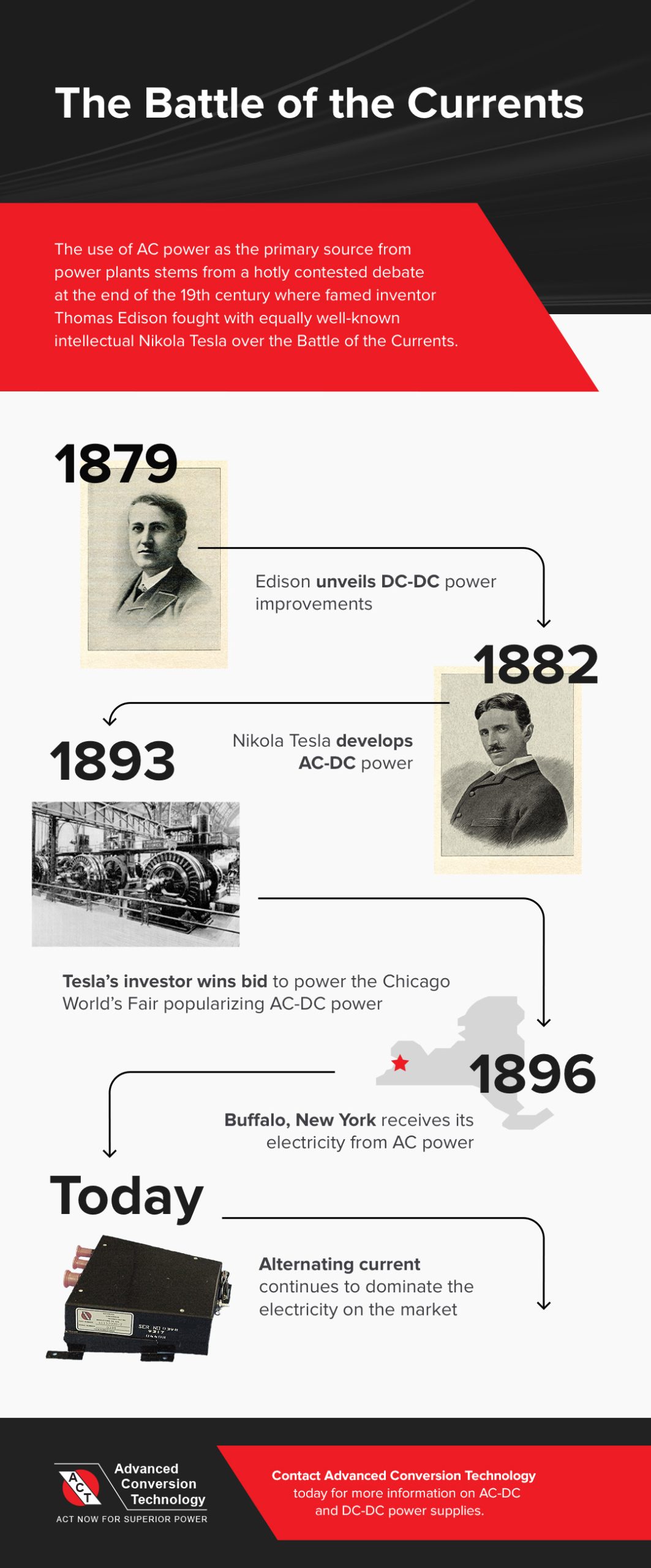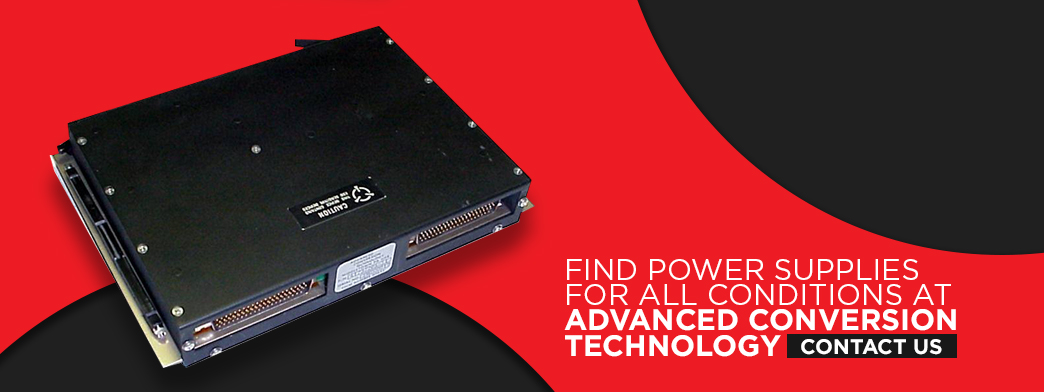
Quick Navigation:
- What is AC Power?
- What is DC Power?
- Why are there Two Different Power Types?
- What is the Difference Between an AC and DC Power Supply?
- How Does an AC-DC Power Supply Work?
- How Does a DC-DC Power Supply Work?
- How to Know if a Power Supply is AC or DC
Power supplies are designed to convert a power source into the type of electricity you need. Some of the most well-known devices convert from AC to DC power, but you can also choose DC to DC power supplies. Knowing the differences between AC vs. DC power supplies and when to use each will help you decide when to purchase.
What Is AC Power?
Alternating current (AC) power is the standard electricity format from outlets. The name comes from the waveform the current takes. To understand the composition of the AC wave, you need to understand that electrical currents come from a flow of electrons. As the electrons in an AC wave move, they can move in a positive direction, corresponding to the upward part of the sinusoidal wave created by the current. When the electrons have a negative flow, the wave drops down.
These waves come from alternators at electrical power plants, which create AC power. Inside an alternator, a wire loop spins inside a magnetic field. The spinning creates waves of alternating current when the wire moves into areas of different magnetic polarity. For instance, the current changes direction when the wire spins from the north to the south pole areas of the magnetic field. The waves created in the alternator are significant for AC power’s use.

The wave-like motion of AC power gives it an advantage over DC power. Because it moves in waves, this electricity format can travel farther than DC power. Most outlets in buildings provide AC power. While many electrical devices such as lamps and appliances use AC power, others require converting the electricity into DC format.
What Is DC Power?
Direct current (DC) power uses electrons that move straightly. In contrast to AC’s wave motion, this linear movement gives this current its name. This form of current comes from batteries, solar cells, fuel cells, alternators equipped with commutators that create direct energy, and rectifiers that convert from AC to DC power.
Most electronics require this power type because DC power is so consistent in the voltage delivered. That’s why most electronics have DC power sources in the form of batteries or need to convert AC power from the outlets to DC power through a rectifier. Power supplies often have rectifiers built in along with transformers to raise or lower the voltage to the appropriate level.
Constant voltage is preferable for some devices, such as notebook computers. If you want to run these electronics from an outlet, you need an AC-DC power converter. The converter transforms the waveform into a steady, straight line. Direct current is preferable for electronics because the highs and lows of alternating current can damage the delicate components inside electronic devices.

Why Are There Two Different Power Types?
The use of AC power as the primary source from power plants stems from a hotly contested debate at the end of the 19th century. At that time, famed inventor Thomas Edison fought with equally well-known intellectual Nikola Tesla over the Battle of the Currents.
Edison had developed DC power and wanted that form to be the preferred power delivered to homes and businesses. His early work in DC power contributed to many cities using this as their default electricity source. Direct current power was not perfect, though. With this electricity source, changing its voltage and delivering DC power over long distances was difficult. Tesla believed AC power would solve these two problems.
George Westinghouse, who had financial control over Tesla’s induction AC motor, underbid Edison to power the Chicago World’s Fair in 1893. That lower bid ensured those who attended the fair would experience a shining city powered by alternating currents. That same year, Buffalo, New York began constructing a hydroelectric power source using Niagara Falls. Three years later, the entire town of Buffalo received its electricity from AC power created by the motion of the falls. Seeing the success of AC power in Buffalo, General Electric, which had previously supported Edison’s direct current stance, began selling AC power.
Today, alternating current continues to dominate the electricity market. Power outlets bring AC power into buildings, where it may find immediate use or need conversion into DC power. Though Edison lost the overall Battle of the Currents, the war did not end there. Many electronics today require the smooth, even voltage of DC power. Both energy types remain essential today because DC electricity is still in use.
Because both electricity types continue to contribute power today, you may have devices that run on DC power and have an AC power source. For these, you will need an AC-DC power supply. These supplies convert the voltage into direct current and adjust the voltage up or down according to the device’s output.
Additionally, many portable electricity generators store power in direct current batteries. For applications in far-flung locations, battery power, fuel cells, or solar cells, which provide DC power, are more readily available than AC power from electricity lines. In these situations, DC-DC power supplies may be required to change the output voltage for a device’s use.

AC vs. DC Power Supply – What’s the Difference?
As noted, the main difference between AC and DC power is the direction the electrons flow. This distinction leads to all other differences between these types of electricity. The wave motion of AC power helps this power source travel farther very efficiently because power plants can easily generate large amounts of AC power and deliver it via power lines, which then feed to transformers to step down the voltage until it reaches homes and businesses. When changing the voltage, DC power does not increase or decrease as easily, and therefore cannot travel long distances efficiently.
What is also important to note is the difference between AC and DC power transmission. The power source and its supply are different — the source comes from the transmission lines and feeds electricity directly into a device or through a power supply that converts the power into another form or voltage.
Consider whether the electricity comes from a battery or an outlet when comparing AC power and DC power sources. Most outlets supply AC power, whereas batteries are the most common DC power source.
How Does an AC-DC Power Supply Work?
You may require AC-DC power supplies to power many devices in a building. These units include transformers to change the voltage, rectifiers to convert to DC power, and a filter to remove some electronic noise from the high and low AC power waves. Even when the power changes from AC to DC, the waves remain, creating an output voltage ripple of higher and lower voltage. Some power supplies have multiple output power options, like this one, which gives people more flexibility in their applications.

In fact, if you’re not certain whether an electrical device needs unregulated or regulated power, err on the side of caution and choose regulated. While the ripple voltage may have little effect on most conventional electrical devices, it does impact electronics. To avoid damaging the components inside electronics, you will need an AC-DC power supply with a regulator.
Regulated power supplies may be linear or switching, depending on the mechanism they use to reduce the ripple voltage from the power. Switching power supplies uses pulse width modification. The benefits of this technology include the ability to add adapters for foreign use, have higher capacities, and step voltage up or down. Unfortunately, switching power supplies cost more and occasionally generates small amounts of electronic noise when switching. These downsides, however, don’t surpass the advantages of a switching power supply.
Linear power supplies lack the efficiency and versatility of switching ones. These devices have a large transformer that can only step down voltage, so they are useless if you have high voltage requirements. The larger size of the unit often generates more heat compared to a switching power supply, but they are quiet and ideal for communications or medical facilities. If you have older devices or need a quiet operation, a linear regulated power supply may be a better choice for smoothing out the ripple voltage in the output power form. As the name suggests, linear power supplies operate in a single line to deliver electricity through the system in one direction.
Switching power supplies have a more complex operation that, counterintuitively, makes them more efficient. With these power supplies, you truly get what you pay for. Poorly made regulated switching models may have only slightly less ripple in the output than unregulated power supplies. Carefully evaluate the power supply model and its construction before investing in it. These power supplies start with AC power and send it through a rectifier to change to DC power. Transistors then convert the DC power back to AC power, this time with a square wave. Then, it can move up or down in voltage through the transformer. Finally, the correct voltage passes through a rectifier again to turn back to DC power, which moves through the filter to reduce output voltage ripples.
Regulating the power out of the device reduces output voltage ripple, ensuring clean DC power. Regulated DC power is a necessity for devices that rely heavily on the smoothest power without changes in voltage. The decision of whether you need regulated or unregulated power does not disappear if you need a DC-DC power supply. Thanks to the unexpected way these devices work, you will still need to choose whether you need clean output power.
How Does a DC-DC Power Supply Work?
Some devices, such as a vehicle battery or solar cell, start with DC power. The voltage from the source may exceed the needs of the device plugged in. Because DC power is difficult to change, DC-DC power supplies often include inverters and rectifiers to convert the DC power first into AC power. The AC power moves into a transformer to change the voltage. After the power supply attains the correct voltage, the electricity travels to the rectifier, where it converts back to DC power.
As with AC-DC power supplies, DC-DC models may require regulators to smooth out the signal. By converting the voltage into AC power, ripple voltage appears in the electrical current. A regulator reduces the output voltage ripple to produce cleaner energy in the output. Devices that do not need a perfectly smooth voltage can use unregulated power supplies, which often cost less. If you must use a DC-DC power supply for a delicate device, however, you will need the cleaner output of a regulated power supply.
How to Know If a Power Supply Is AC or DC
If you have ever wondered how to tell if a power supply is AC or DC, you must know the differences between AC and DC power supplies and be observant of the device itself. One way to determine if you have an AC-DC power supply or a DC-DC model is to look at the device itself. Often, the input and output information will appear somewhere on the surface. If the input is AC, you have an AC-DC power supply, and if the input and output both are DC, you have a DC-DC model.
While you already know that AC power sources include outlets, that information becomes useless if you have a device aboard a ship or on a plane. How do these parts get power? An onboard generator or an engine battery could create the electricity needed. If you’re not sure of the power source for a device, contact us at ACT. We have experts who can walk you through identifying the type of power supply you need.
The power supplies you have are just as important as what you power. To protect your electrical devices from damage, provide them with the power supplies to create the right voltage and current type the device requires without surpassing your budget constraints. Should you have questions or need to acquire AC or DC power supplies, we can help.
Find Power Supplies for All Conditions at Advanced Conversion Technology
Get durable power supplies designed to withstand even the most extreme conditions. Whether you need AC-DC power supplies that transform electricity or DC-DC units that change voltage without altering the current type, Advanced Conversion Technology (ACT) has them. Browse our options to find the right devices for your needs.
While we offer a wide range of power supplies in both AC-DC and DC-DC formats, you may have particular needs that require a specific option. If you cannot find the perfect power supplies in our catalog, contact us so we can create a specialized solution for you.
